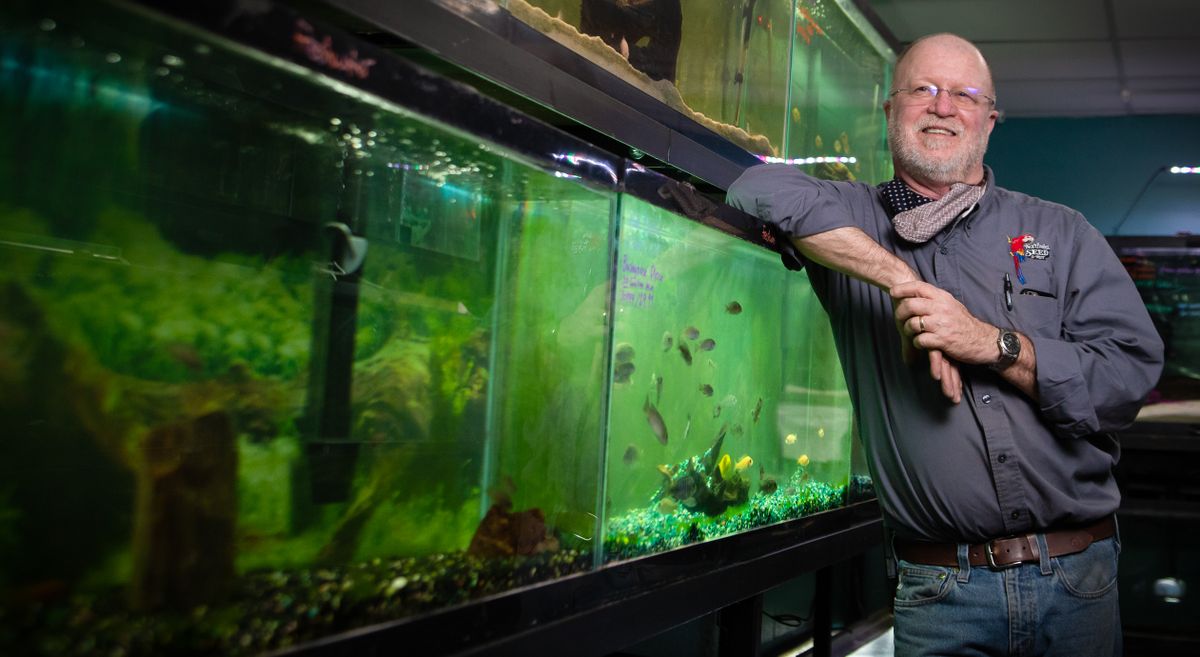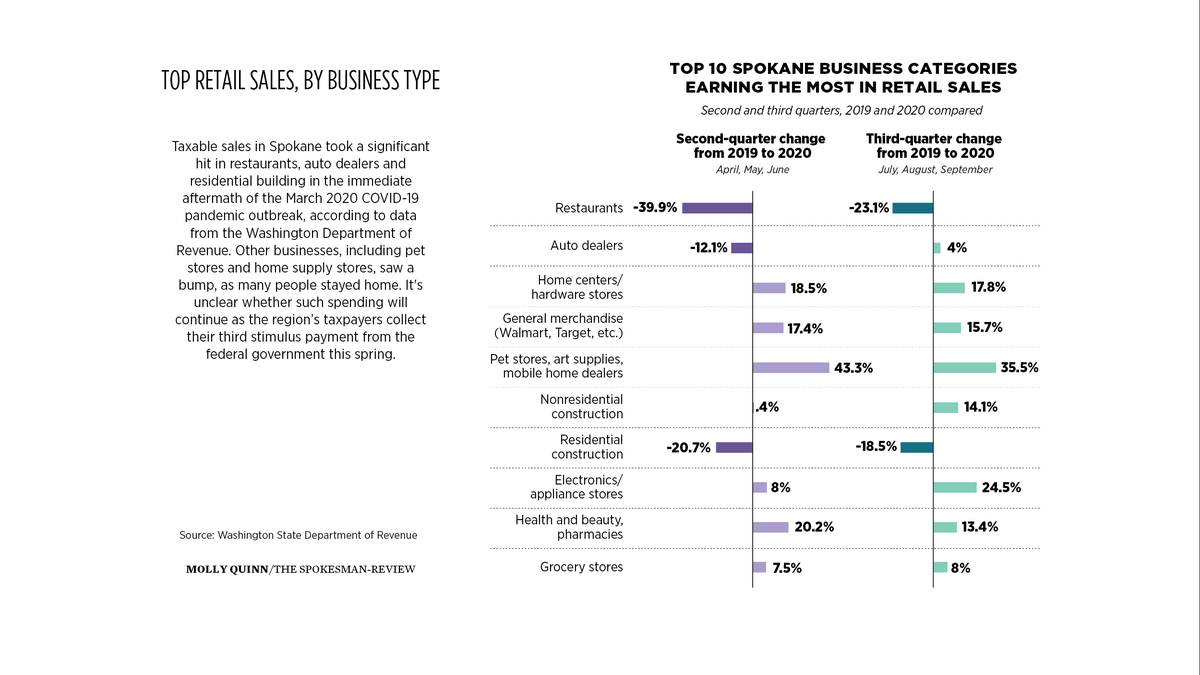Stimulating Spokane: Previous rounds of assistance checks went to essentials, savings; third round might be different
Bob Mauk, owner of Northwest Seed and Pet, pauses for a portrait in the fish area of his Sprague Avenue store on Tuesday. Mauk said the store already has sold much of its seed stock. (Libby Kamrowski/The Spokesman-Review)Buy a print of this photo
The windfall of Lisa Randall’s stimulus check sat sunning itself in the grass in the U.S. Pavilion on Tuesday afternoon.
“Most people got their COVID puppies a year ago,” said Randall, who was taking a day off work to entertain her children and granddaughter, Annika, and also walk her new 11-week-old herder mix, Leo. “I’m a late bloomer.”
A portion of Randall’s third round of federal assistance, authorized as part of a $1.9 trillion COVID-19 assistance package, was used to adopt Leo. If the data from the city of Spokane is any indication, she wasn’t alone.
While much of the first two rounds of direct payments, often referred to as stimulus checks, was used by Americans to pay off debt or add to their savings, consumer spending in the second and third quarters of 2020 indicate a boost to pet and garden stores, including Spokane’s Northwest Seed and Pet.
“It was more immediate, and more extreme,” said Bob Mauk, owner of the stores on Sprague Avenue and Division Street. “I’ve never seen us sell out of seeds before, and we basically sold out of seeds.”
The data show that the first round of stimulus payments were used by low-income households to pay for essentials, including housing and food. Higher-income homes either paid down debt or saved for the future, or both.
Megan Tiffany, a 24-year-old college student visiting Riverfront Park from Ephrata, said she’d used the money to pay off credit card and medical debt. The rest is going toward savings, to help her find housing independent of her parents, she said.
“It has been really helpful,” Tiffany said of the stimulus payments. “I’ve been building up money.”
Hannah Lane and her husband, Alexian, chose to set aside a bit of money for themselves with each round of assistance, and used the rest to pay off some of her student loans.
“We have been making slow but steady progress with paying down debt, and as much as we would have enjoyed doing something fun, it feels good to know we were able to take another step toward more financial freedom,” Hannah Lane said.
Washington state taxpayers received $6 billion of the direct payment assistance issued by the government in that first round of checks, according to an analysis by the University of Pennsylvania’s Wharton School of Business.
The trend of saving over spending is likely to continue, said Patrick Jones, a professor of economics at Eastern Washington University and the director of the school’s Institute for Public Policy and Economic Analysis. Unemployment remains high and many stimulus recipients still have debts to pay off. But there are indicators from last year’s economic activity in town that suggest what citizens may use any extra cash to buy, beyond food for Fido.
“I anticipate that people will be spending in areas that they’ve been stymied to spend in,” said Jones. That includes the hospitality industry, live entertainment and travel, all sectors that took a significant hit in the second quarter of 2020, according to data available from the state’s Department of Revenue.
In the city of Spokane, restaurants reported revenue of $87 million during the months of April, May and June 2020, following orders to pivot to takeout in the early months of the pandemic. That’s a 40% drop from the same period the prior year, which saw $145 million in sales.
Hotels and lodging fared even worse. Spokane accommodations reported $7.4 million in sales during the second quarter of 2020, a drop of 80% from the year prior, when they made $35.7 million.
If any area is going to see a major uptick in spending, it’s those industries that were either forced to close, or that consumers moved away from and that are becoming more available as people get vaccinated and case numbers decline, Jones said.
The question still remains if Americans will approach this round of payments differently than they did a year ago, when the first round of $1,200 checks arrived in bank accounts. An analysis from the Federal Reserve Bank of New York in October found that taxpayers divided their first checks pretty evenly among consumption, savings and paying off debt, with more than half of that consumption spending on essentials, including housing and food.
That finding, and other factors, have led the Wharton School of Business to anticipate that about 27% of the money arriving via check, direct deposit or debit card this spring will be spent, with the rest remaining in savings accounts or going to pay off credit card, student loan or other debt.
The American Relief Act is more targeted at lower-income earners than previous packages, Jones said, and because of that could lead to more spending. The New York Fed analysis showed that spending and debt payment was highest among households making less than $40,000 annually, while those making more than $75,000 saved more than 40% of their checks.
“I suspect spending as a percentage would creep up this time around, just because of the targeting that’s gone on,” Jones said.
It’s also possible to look at what spending occurred a year ago to try to anticipate where those checks may be going in 2021.
While hospitality spending declined, other areas of the economy saw a significant bump in the second quarter of 2021. Pet stores, which are lumped in a category with other miscellaneous retail in the reporting conducted by the Department of Revenue, increased their earnings by 43% in the second quarter of 2020. Home good stores also increased by more than 19%.
Mauk, the owner of Northwest Seed and Pet, said there was significant demand in the early months of the pandemic for both the gardening and pet supplies he stocks .
Part of the empty shelves could have been explained by early supply chain issues, Mauk said, but is likely due to the lack of options for spending that Jones talked about.
“I think it’s just a switch from spending their money going out, for entertainment, and other things they quit doing,” Mauk said.
The typical big ticket items you’d expect stimulus checks to go toward – electronics and other luxury purchases for those who’ve met their housing and essential needs – did see a bump later in the year. Automobile dealers in Spokane reported a 12% decline in sales during the second quarter of 2020, only to see a 3% increase in revenue the following quarter.
“Sales have been very robust. We had a really bad down period, and since then they’ve been robust,” said Vicki Giles Fabre, executive vice president of the Washington State Auto Dealers Association.
Other goods considered a luxury have also been in high demand. Sky Dornbirer, who works in retail guitar sales at Hoffman Music, said the stringed instruments have been flying off shelves all year.
“I’ve definitely had people say when the stimulus comes in, we’re buying guitars,” he said.
Ann Bennett, of Spokane, said she’d used the first couple of rounds of assistance on groceries and to help pay for her son’s wedding. But with the most recent round of assistance, she bought herself a new tablet computer, a Microsoft Surface Pro.
“I did the good old-fashioned American thing,” Bennett said, referring to the theory that stimulus money should be spent in the economy to get businesses back on their feet.
Jack Nunes, an 88-year-old U.S. Army veteran, said he spent his first rounds of assistance on puzzles, clothing and two new pairs of walking shoes. He lives in an assisted living facility near downtown and needed things to keep him occupied during the shutdown.
“Why would you save it?” Nunes said of the money. “Are you going to wait until prices get higher?”
The question in the coming months will be whether demand for those goods continues as people find themselves with additional money.
The likely end of moratoriums on evictions and foreclosures could mean that more people take their payments and prepare for necessary spending on essentials. But there is evidence of what economists call “pent-up demand,” particularly for goods and services that have gone by the wayside with more folks at home, Jones said.
“There’s very high savings, the highest for decades,” he said. “There’s just a greater likelihood that people will spend more than they would have, had they had a savings rate that was lower.”

